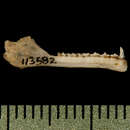en
names in breadcrumbs


H. underwoodi is the only species in the genus Hylonycteris. The name literally means 'forest bat'.
Communication in H. underwoodi has not been described. Like most mammals, these bats communicate among themselves using sounds, chemical cues, touch, and behaviors. These microchiropterans use those same cues to perceive their environment. They use echolocation as well to navigate and locate food.
Communication Channels: visual ; tactile ; acoustic ; chemical
Perception Channels: visual ; tactile ; acoustic ; ultrasound ; chemical
Hyloncyteris underwoodi is currently listed as 'Lower Risk / Near Threatened' by the IUCN .
US Federal List: no special status
CITES: no special status
IUCN Red List of Threatened Species: least concern
There are no known adverse effects of H. underwoodi on humans.
Hylonycteris underwoodi probably disperses seeds and aids in the pollination of plants that are important to humans.
Positive Impacts: pollinates crops; controls pest population
In general, frugivorous bats are able to spread seeds for long distances and are notorious for aiding in pollination of certain plants. However, little is known about specific roles of H. underwoodi.
Ecosystem Impact: disperses seeds; pollinates
Hyloncyteris underwoodi individuals eat primarily nectar and pollen. They also sometimes eat fruit .
Plant Foods: fruit
Primary Diet: herbivore (Nectarivore )
Underwood's long-tongued bats range from western Panama to Nayarit and Vera Cruz, Mexico. Hyloncyteris underwoodi is endemic to Central America.
Biogeographic Regions: nearctic ; neotropical
Underwood's long-tongued bats seem to be limited to forested, tropical regions between 50 and 2640 meters elevation. They prefer dense vegetation consisting of deciduous trees forming a full canopy. Roosts have been recorded in hollow logs, under bridges, in caves, and in tunnels.
Range elevation: 50 to 2640 m.
Habitat Regions: tropical ; terrestrial
Terrestrial Biomes: forest
The lifespan of H. underwoodi is unknown.
Hylonycteris underwoodi individuals have long, narrow muzzles and long, extensible tongues. They are small-bodied with short tails and well-developed interfemoral membranes. Body mass ranges from 6 to 9 grams, head and body length ranges from 65 to 70 millimeters, and forearm length from 31 to 35 mm. The fur is uniformly dark gray, with the lower surfaces being slightly paler. The lower lip has a wide groove above it, surrounded by small warts. This bat also has distinctive zalambdodont teeth with the inner upper incisors larger than the outer ones. They lack lower incisors . The skull has an incomplete zygomatic arch. The small size of Hyloncyteris underwoodi may aid in maneuverability in flight.
Range mass: 6 to 9 g.
Range length: 65 to 70 mm.
Average length: 67 mm.
Other Physical Features: endothermic ; homoiothermic; bilateral symmetry
Sexual Dimorphism: sexes alike
There is no information regarding predation on H. underwoodi. The most likely predators on these bats are birds of prey, such as falcons and owls, snakes, and other small, arboreal predators.
The mating system is not known.
Although very little is known about reproduction in H. underwoodi, they are thought to be monoestrus. Females have a yearly cycle of oestrus, pregnancy, and lactation and usually have one offspring. This is commonly found in phyllostomid bats.
Breeding interval: Underwood's long-tongued bats reproduce once a year.
Breeding season: The breeding season in these bats is unknown.
Range number of offspring: 1 to 2.
Average number of offspring: 1.
Key Reproductive Features: iteroparous ; gonochoric/gonochoristic/dioecious (sexes separate); sexual ; viviparous
Parental care in H. underwoodi has not yet been described. Females care for and nurse their young in maternity roosts until they reach independence.
Parental Investment: female parental care
Underwood's long-tongued bat (Hylonycteris underwoodi) is a species of bat in the family Phyllostomidae. It is the only species within the genus Hylonycteris. It is found in Belize, Guatemala, Mexico, Nicaragua, and Panama. Hylonycteris underwoodi feed on nectar, pollen grains, agave and fruits.[2] This choice of food has allowed them to gain the ability of hovering flight, thereby evolving their body mass and size to compensate for the same.[3]
It was described as a new species in 1903 by British mammalogist Oldfield Thomas. The holotype was collected by Cecil F. Underwood, who is the eponym for the species name "underwoodi".[4]
Underwood's long-tongued bat (Hylonycteris underwoodi) is a species of bat in the family Phyllostomidae. It is the only species within the genus Hylonycteris. It is found in Belize, Guatemala, Mexico, Nicaragua, and Panama. Hylonycteris underwoodi feed on nectar, pollen grains, agave and fruits. This choice of food has allowed them to gain the ability of hovering flight, thereby evolving their body mass and size to compensate for the same.